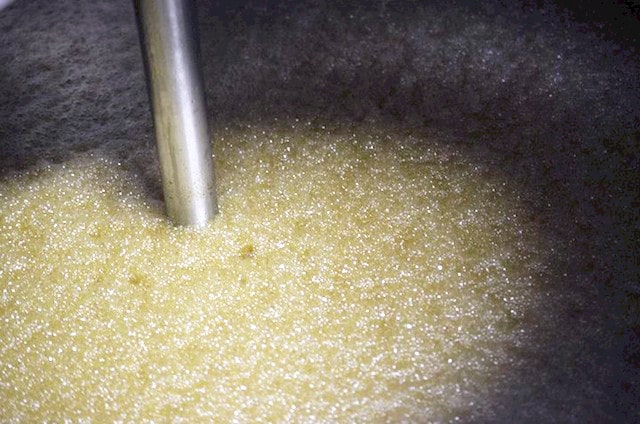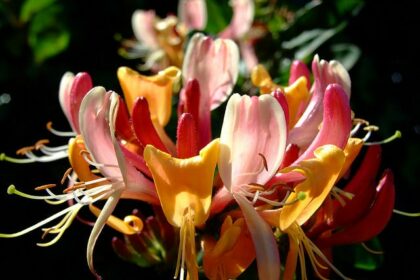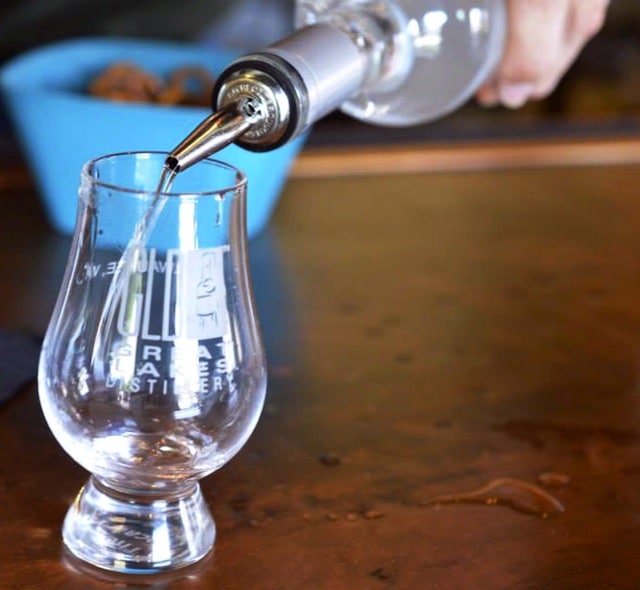
Since I’ve been in Milwaukee, it’s been impossible to ignore the many breweries and brew pubs that line the streets. And while I love trying new craft beers, my real passion when it comes to drinking is spirits. Which is why I am full of excitement as I step into the red brick building that is Great Lakes Distillery.
My eyes immediately settle on the tasting bar set up with snifter glasses, water and pretzels. In the corner, shelves are lined with bottles, glasses and homemade bitters. And as I walk toward the stairs, following owner Guy Rehorst toward the distillation area for a distillery tour, the sweet scent of fermenting molasses consumes me. I think I’ve died and gone to heaven.
Before talking the Great Lakes Distillery’s small-batch spirits, it’s worth going back in time to look at Milwaukee’s distilling history. Prior to the Civil War, spirits were inexpensive and flowed plentifully; however, during the Civil War the government imposed a $1 per barrel tax on beer and whiskey. If this wasn’t bad enough, the tax was raised to $2 per barrel after the war. At this time Milwaukee had eight distillers: Otto Bierbach, Brunst & Casperi, Koeffler Bros., O’Neill & Reynolds, Rindshopf & Son, J.B. Schram, P. Young, and Schuckman and Waldeck. These hardworking ventures tried to find loopholes to lessen the tax, but in the end many were forced to shut down their business. By 1916, there were only two distillers left, both of which closed down during Prohibition. Luckily, the Great Lakes Distillery is bringing back Milwaukee’s tradition of not only drinking beer, but high-quality spirits, as well.
My first impression of Milwaukee is that these people love to drink, and they like to drink well. The Great Lakes Distillery reinforces this idea, as they create small-batch premium spirits made mainly with local ingredients. All spirits are crafted in a one-room basement, as it’s a small operation. Originally, Guy was a home brewer and wine maker, and started to get curious about distillation. At the same time, he realized that while most bars and restaurants had locally made beer and even wine, there were no local spirits. In 2004 he made the decision to investigate the idea as a business and was able to officially open the distillery in 2006.
He talks about how fermenting mash is known as a beer if it’s made from grain, and is called a wine if it’s made from fruit. Once the fermentation is complete it is placed in the still and distillation — the separation of the alcohol from the mash — begins. I’m instructed to climb to the top of a ladder and look into one of the fermenters, where I can see a bubbling concoction of molasses and yeast. To my untrained eye it looks like oatmeal being cooked, although if you inhale the molasses too deeply you’re sure to be knocked right on your butt.
Next, Guy takes me over to where the barrels are located and picks up a piece of wood.
“One of the most important components of the distillation process is the wood,” he explains, showing us the planks typical charred sides.
Apparently, brown spirits like whiskey and rum get their color from the wood of the barrels. As the spirit is forced into the wood the charred barrel filters out certain undesirable flavors and, over time, very complex flavors develop as the alcohol extracts flavors, such as vanilla or caramel, in from the wood. For Great Lakes Distillery spirits, Guy especially enjoys using American white oak.
“It has a course grain which is more conducive to aging high proof alcohol,” he explains. “It will more readily give up the flavors we desire in a whiskey when compared to french oak which is preferred by winemakers.”
What’s really interesting to me on the tour is learning about the various myths that exist about vodka. Vodka is made by cooking grain mash at a very high temperature and proof level, meaning there is a high concentration of alcohol. While the process is supposed to eliminate all flavors — by law, vodka is an odorless, colorless substance — some unpalatable flavors still remain. To help combat the idea that vodka has a chemical taste, marketing companies like to create an allure with misleading information. According to Guy, despite the fact distillers often talk about the quality of the local water they source for their spirits, the truth is all water needs to go through the same filtering process, meaning the purity of the local water isn’t really a concern. Moreover, because consumers love to hear numbers marketers will often say things like the vodka was “filtered 12 times” or “distilled six times.” In reality, these numbers don’t really matter unless you know the context of how the spirit was filtered or distilled.
Guy laughs. “Was it filtered through a Dixie Cup or a charcoal filtration system? Without this information the amount of times the vodka was distilled won’t matter. And to be honest I’ve had vodkas that were filtered only two times that tasted better than the one filtered 12 times.”

After the tour, Guy takes me upstairs for a tasting of the products. We begin with the Rehorst Vodka, which is made with Wisconsin-grown wheat and uses the above-mentioned charcoal filtration system for a cleaner, smoother vodka. This is because charcoal contains carbon, which is effective in absorbing odors and colors from liquids. They also don’t claim to filter any certain number of times, as their philosophy is they’ll filter the vodka as many times as needed to get the right flavor. Moreover, there are no additives, as the spirit features a natural sweetness. I find it has a nice warming effect, and goes down smoother than many other vodkas I’ve tried. In fact, it makes me think I could actually enjoy a vodka martini if it featured this particular label.
I swirl my glass to try to inhale some of this sweetness, but Guy stops me. “While swirling wine will aerate it, swirling a spirit will just bring more alcohol to the nose and it’ll taste stronger.”
I keep this in mind as we move on to the Rehorst Citrus & Honey Rum. While most citrus spirits don’t contain real fruit but instead the citric acid from corn, Great Lakes Distillery uses real lemon. The spirit is also made using pure local honey and the zest of flowers, which is what you smell and taste. Surprisingly, it doesn’t contain that harsh chemical scent I find many vodkas have. Sipping it, I can imagine it would be great in a mixed drink, like a cranberry vodka or vodka tonic.
The tasting continues with the Rehorst Gin. I’m not usually a gin fan due to its tendency to have an overpowering amount of juniper; however, Great Lakes Distillery’s take on the spirit is one I find enjoyable. It features nine botanicals, some of which include coriander, cardamom, lemon peel, orange peel and, of course, juniper berries. Guy also puts a unique spin on it by adding two unusual ingredients, sweet basil and Wisconsin ginseng. Interestingly, about 90% of Wisconsin ginseng is imported to Asia, as it’s an extremely high-quality ingredient. While the first sip of the gin is an explosion of flavor, the second sip is smoother, with the flavor of juniper flowing smoothly into the essence of sweet basil and lingering pleasantly on the tongue. This particular tasting shows me you should never rule out an entire type of spirit, as different labels can have completely different qualities.
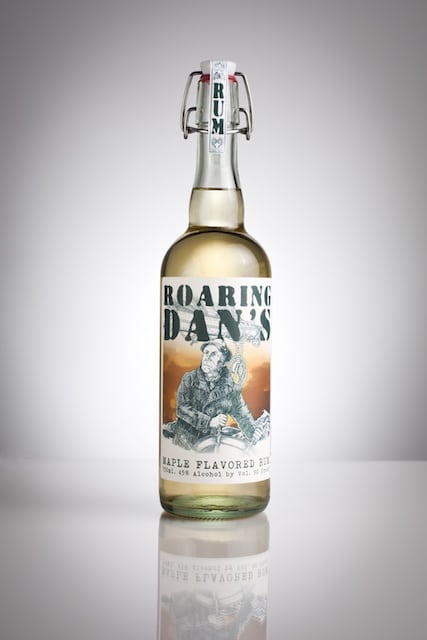
The Roaring Dan’s rum is a fun tasting. Because every rum needs a pirate, the spirit is named after Roaring Dan Seavey, a saloon and brothel owner in Milwaukee and the Great Lakes’ only pirate. Having a local mascot drives home the fact Great Lakes Distillery is passionate about going local. The rum features grade “A” sugar cane molasses and pure Wisconsin maple syrup. Although there are heavy maple syrup notes on the nose with a hint of vanilla, the rum is surprisingly dry with a enjoyable bite and has a slight hint of whiskey, probably because it’s aged in American white oak barrels and used bourbon barrels. I imagine mixing it with a cream soda would be delicious.
Although by this point I’ve tasted many enjoyable spirits, what I’m most excited for are the last two, a whiskey and an absinthe. First I sample the Kinnickinnic Whiskey. Kinnickinnic is an Ojibwe word meaning “what is mixed,” which is an appropriate name as it blends together three different kinds of whiskey for a north-meets-south spirit: A Straight Bourbon sourced from down south and their own Malt Whiskey and Rye Whiskey. It’s unfiltered, which really brings out the flavors, and and smells of toffee, spice, caramel and leather. What’s interesting to note is that while most blended whiskeys feature mostly Neutral Grain Spirit, which is basically vodka, Great Lakes Distillery’s take on it features only high-quality whiskeys. In fact, among other awards, their Kinnickinnic Whiskey won “Best American Blended Whiskey” at the 2013 World Whiskies Awards in March.
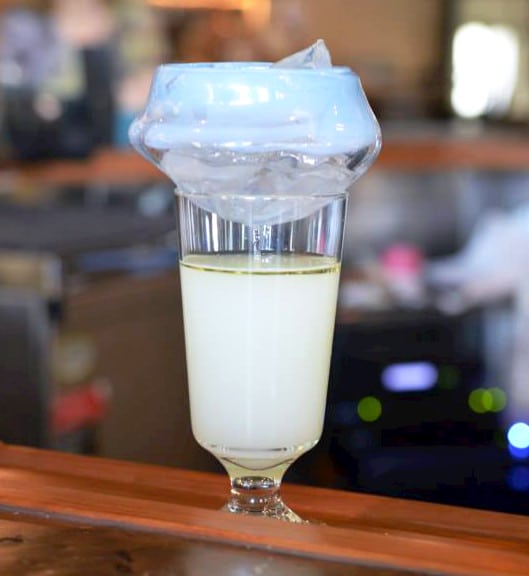
And for the grand finale, Guy puts on a bit of a show. Taking a glass topped with a hard sheet of ice, he pours Great Lakes Distillery’s Amerique 1912 Absinthe Verte over the top. In the glass a light green liquid appears, followed by the “green fairy,” a dark green layer on the top. Despite the fact absinthe was banned in the United States in 1912 because people thought grande wormwood made people violent, Guy uses a traditional recipe of anise, grande wormwood and fennel. While in the past I’ve tried absinthe that I found to be extremely harsh on the palate, this one is pleasant, with a taste of black licorice that’s noticeable but not overbearing and a warm, lingering finish.
Before leaving, I stop by their stand of handmade bitters. Apparently they’re created by a local shop called Bittercube, which has an array of artisanal bitters for those who want to get creative with their mixology skills. I grab two bottles, a “Jamaican #1” whose flavor profile contains allspice, ginger and black pepper, and a “Cherry Bark Vanilla” with a flavor profile of wild cherry bark, Madagascar vanilla and cocoa.
I turn to guy. “Do you think I could combine these two bitters into some kind of cocktail?”
He thinks for a moment then smiles. “Try it. Experimentation is the most exciting part of making cocktails.”
Jessica Festa
Latest posts by Jessica Festa (see all)
- A Culturally-Immersive Adventure In Mongolia’s Altai Mountains - Jul 8, 2023
- This Recipe Sharing Platform Supports Women In The Culinary Industry (Labneh Recipe Included!) - Nov 5, 2020
- Hiking The Mohare Danda Community Eco-Trek In Nepal - Jun 3, 2020
- 6 Important Questions For Choosing A Responsible Yoga Retreat - May 18, 2020
- How To Create & Grow A Profitable Blogging Business (Ethically) - Jan 18, 2020


